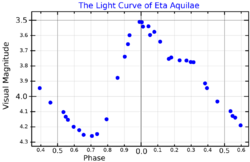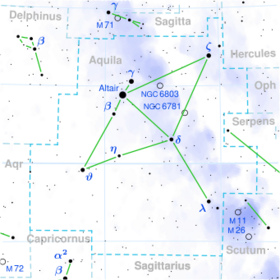Astronomy:Eta Aquilae
| Observation data Equinox J2000.0]] (ICRS) | |
|---|---|
| Constellation | Aquila |
| Right ascension | 19h 52m 28.36775s[1] |
| Declination | +01° 00′ 20.3696″[1] |
| Apparent magnitude (V) | 3.87[2] (3.48 to 4.33[3]) |
| Characteristics | |
| Spectral type | F6 Iab + B9.8 V[4] + F1-5 V[5] |
| U−B color index | +0.51[6] |
| B−V color index | +0.89[6] |
| Variable type | δ Cep[3] |
| Astrometry | |
| Radial velocity (Rv) | –14.8[2] km/s |
| Proper motion (μ) | RA: +6.91 mas/yr Dec.: –8.21 mas/yr |
| Parallax (π) | 2.36 ± 1.04[1] mas |
| Distance | approx. 1,400 ly (approx. 400 pc) |
| Absolute magnitude (MV) | −3.70[4] |
| Details | |
| A | |
| Mass | 5.7[4] M☉ |
| Radius | 66 ± 22[7] R☉ |
| Luminosity | 2,630[4] L☉ |
| Surface gravity (log g) | 1.5[8] cgs |
| Temperature | 6,000[8] K |
| Metallicity [Fe/H] | +0.10[8] dex |
| B | |
| Mass | 2.3[4] M☉ |
| Age | 26.4 ± 3.1[9] Myr |
| Other designations | |
55 Aquilae, BD+00°4337, FK5 746, HD 187929, HIP 97804, HR 7570, SAO 125159, AAVSO 1947+00, 2MASS J19522835+0100203 | |
| Database references | |
| SIMBAD | data |
Eta Aquilae (η Aql, η Aquilae) is the Bayer designation for a multiple star in the equatorial constellation of Aquila, the eagle. It was once part of the former constellation Antinous. On average, this star has an apparent visual magnitude of 3.87,[2] making it one of the brighter members of Aquila. Based upon parallax measurements made during the Hipparcos mission, this star is located at a distance of roughly 1,382 light-years (424 parsecs), although the parallax estimate has a 44% margin of error.[1]
System
The η Aquilae system contains at least two stars, probably three. The primary star η Aql A is by far the brightest and dominates the spectrum. An ultraviolet excess in the spectral energy distribution suggest the presence of a faint hot companion, η Aql B, which has been given a spectral type of B8.9 V. The fractional spectral type is an artefact of the mathematics used to model the spectrum, not an indication of any specific spectral features that would be intermediate between B8 and B9.[4] Radial velocity measurements could not find a satisfactory fit, which suggests that the orbit of η Aql B may be face-on, or very large.[10]
A companion has been resolved visually 0.66" distant, but measurements give this a spectral type of F1 - F5. It seems likely that the hot star detected in the spectrum is closer and unresolved. The resolved companion has not been shown to be physically associated, but it is estimated that it would have a period of nearly a thousand years. Measurements with the HST fine guidance sensors show variations likely to be due to orbital motion on a scale of two years, so η Aql would appear to be a triple system.[4][5]
Cepheid Variable

η Aquilae A is a Cepheid variable star, discovered by Edward Pigott in 1784.[12] It has an apparent magnitude that ranges from 3.5 to 4.3 over a period of 7.176641 days.[3] Along with Delta Cephei, Zeta Geminorum and Beta Doradus, it is one of the most prominent naked eye Cepheids;[13] that is, both the star itself and the variation in its brightness can be distinguished with the naked eye. Some other Cepheids such as Polaris are bright but have only a very small variation in brightness.
At the relatively young age of 26 million years,[9] this massive star has burned through the hydrogen fuel at its core and evolved into a supergiant, giving it a baseline stellar classification of F6 Ibv.[9] The periodic pulsations of this star actually cause the stellar class to vary between (F6.5–G2)Ib over the course of each cycle.[14]
Compared to the Sun, Eta Aquilae has around 9[9] times the mass, roughly 66[7] times the radius, and is radiating 11,474[15] times as much luminosity. This energy is being emitted from the outer envelope at an effective temperature of 6,000 K,[8] giving it the yellow-white hued glow of an F-type star. The radius of the star varies by 4.59 × 106 km (0.007 R☉) over the course of a pulsation cycle.[16] Compared to its neighbors, this star has a high peculiar velocity of 16.7 ± 6.9 km s−1.[9]
Name
In Chinese, 天桴 (Tiān Fú), meaning Celestial Drumstick, refers to an asterism consisting of η Aquilae, θ Aquilae, 62 Aquilae and 58 Aquilae.[17] Consequently, the Chinese name for η Aquilae itself is 天桴四 (Tiān Fú sì, English: the Fourth Star of Celestial Drumstick.)[18]
This star, along with δ Aql and θ Aql, were Al Mizān (ألميزان), the Scale-beam.[19]According to the catalogue of stars in the Technical Memorandum 33-507 - A Reduced Star Catalog Containing 537 Named Stars, Al Mizān was the title for three stars: δ Aql as Al Mizān I, η Aql as Al Mizān II and θ Aql as Al Mizān III.[20]
η Aquilae, together with θ Aql, δ Aql, ι Aql, κ Aql and λ Aql, was part of the obsolete constellation Antinous.[21]
References
- ↑ 1.0 1.1 1.2 1.3 van Leeuwen, F. (November 2007), "Validation of the new Hipparcos reduction", Astronomy and Astrophysics 474 (2): 653–664, doi:10.1051/0004-6361:20078357, Bibcode: 2007A&A...474..653V.
- ↑ 2.0 2.1 2.2 Wielen, R. et al. (1999), "Sixth Catalogue of Fundamental Stars (FK6). Part I. Basic fundamental stars with direct solutions", Veröff. Astron. Rechen-Inst. Heidelb 35 (35): 1, Bibcode: 1999VeARI..35....1W.
- ↑ 3.0 3.1 3.2 GCVS Query=eta Aql, General Catalogue of Variable Stars @ Sternberg Astronomical Institute, Moscow, Russia, http://www.sai.msu.su/gcvs/cgi-bin/search.cgi?search=eta+Aql, retrieved 2010-11-24.
- ↑ 4.0 4.1 4.2 4.3 4.4 4.5 4.6 Remage Evans, Nancy; Bond, Howard E.; Schaefer, Gail H.; Mason, Brian D.; Karovska, Margarita; Tingle, Evan (2013). "Binary Cepheids: Separations and Mass Ratios in 5 M ⊙ Binaries". The Astronomical Journal 146 (4): 93. doi:10.1088/0004-6256/146/4/93. Bibcode: 2013AJ....146...93E.
- ↑ 5.0 5.1 Gallenne, A.; Kervella, P.; Mérand, A.; Evans, N. R.; Girard, J. H. V.; Gieren, W.; Pietrzyński, G. (2014). "Searching for visual companions of close Cepheids". Astronomy & Astrophysics 567: A60. doi:10.1051/0004-6361/201423872. Bibcode: 2014A&A...567A..60G.
- ↑ 6.0 6.1 Nicolet, B. (1978), "Photoelectric photometric Catalogue of homogeneous measurements in the UBV System", Astronomy and Astrophysics Supplement Series 34: 1–49, Bibcode: 1978A&AS...34....1N.
- ↑ 7.0 7.1 Nordgren, Tyler E. et al. (December 1999), "Stellar Angular Diameters of Late-Type Giants and Supergiants Measured with the Navy Prototype Optical Interferometer", The Astronomical Journal 118 (6): 3032–3038, doi:10.1086/301114, Bibcode: 1999AJ....118.3032N, http://digitalcommons.wcupa.edu/cgi/viewcontent.cgi?article=1008&context=phys_facpub.
- ↑ 8.0 8.1 8.2 8.3 Luck, R. E.; Lambert, D. L. (May 1981), "The abundances of carbon, nitrogen, and oxygen in the atmospheres of Cepheid variables - Evidence for helium enrichment", Astrophysical Journal, Part 1 245: 1018–1034, doi:10.1086/158879, Bibcode: 1981ApJ...245.1018L.
- ↑ 9.0 9.1 9.2 9.3 9.4 Tetzlaff, N.; Neuhäuser, R.; Hohle, M. M. (January 2011), "A catalogue of young runaway Hipparcos stars within 3 kpc from the Sun", Monthly Notices of the Royal Astronomical Society 410 (1): 190–200, doi:10.1111/j.1365-2966.2010.17434.x, Bibcode: 2011MNRAS.410..190T.
- ↑ Benedict, G. Fritz; Barnes, Thomas G.; Evans, Nancy R.; Cochran, William D.; Anderson, Richard I.; McArthur, Barbara E.; Harrison, Thomas E. (2022). "The η Aquilae System: Radial Velocities and Astrometry in Search of η Aql B". The Astronomical Journal 163 (6): 282. doi:10.3847/1538-3881/ac68ed. Bibcode: 2022AJ....163..282B.
- ↑ Kiss, Laszlo L. (July 1998). "A photometric and spectroscopic study of the brightest northern Cepheids - I. Observations". Monthly Notices of the Royal Astronomical Society 297 (3): 825. doi:10.1046/j.1365-8711.1998.01559.x. Bibcode: 1998MNRAS.297..825K.
- ↑ Pigott, Edward (1785). "Observations of a New Variable Star. In a Letter from Edward Pigott, Esq. to Sir H. C. Englefield, Bart. F. R. S. and A. S.". Philosophical Transactions of the Royal Society of London 75: 127–136. doi:10.1098/rstl.1785.0007. Bibcode: 1785RSPT...75..127P.
- ↑ Basu, Baidyanath (2003), An Introduction to Astrophysics, PHI Learning Pvt. Ltd., p. 171, ISBN 978-81-203-1121-3, https://books.google.com/books?id=1w5f5Po4XV8C&pg=PA171
- ↑ Wiktorowicz, Sloane J.; Matthews, Keith (December 2008), "A High-Precision Optical Polarimeter to Measure Inclinations of High-Mass X-Ray Binaries", The Publications of the Astronomical Society of the Pacific 120 (874): 1282–1297, doi:10.1086/595966, Bibcode: 2008PASP..120.1282W.
- ↑ Hohle, M. M.; Neuhäuser, R.; Schutz, B. F. (April 2010), "Masses and luminosities of O- and B-type stars and red supergiants", Astronomische Nachrichten 331 (4): 349, doi:10.1002/asna.200911355, Bibcode: 2010AN....331..349H.
- ↑ Gray, David F.; Stevenson, Kevin B. (April 2007), "Spectroscopic Determination of Radius Changes of Cepheid Variable Stars", The Publications of the Astronomical Society of the Pacific 119 (854): 398–406, doi:10.1086/518128, Bibcode: 2007PASP..119..398G
- ↑ Ian Ridpath's Star Tales - Aquila
- ↑ (in Chinese) AEEA (Activities of Exhibition and Education in Astronomy) 天文教育資訊網 2006 年 7 月 3 日
- ↑ Allen, R. H. (1963), Star Names: Their Lore and Meaning (Reprint ed.), New York, NY: Dover Publications Inc., p. 61, ISBN 978-0-486-21079-7, https://archive.org/details/starnamestheirlo00alle/page/61, retrieved 2010-12-12.
- ↑ Rhoads, Jack W. (November 15, 1971), Technical Memorandum 33-507-A Reduced Star Catalog Containing 537 Named Stars, California Institute of Technology: Jet Propulsion Laboratory, https://ntrs.nasa.gov/archive/nasa/casi.ntrs.nasa.gov/19720005197_1972005197.pdf.
- ↑ Ian Ridpath's Star Tales - Antinous
External links
- "eta Aql". SIMBAD. Centre de données astronomiques de Strasbourg. http://simbad.u-strasbg.fr/simbad/sim-basic?Ident=eta+Aql.
- Eta Aquilae
- Image Eta Aquilae
Coordinates: ![]() 19h 52m 28.36775s, +01° 00′ 20.3696″
19h 52m 28.36775s, +01° 00′ 20.3696″
 |


